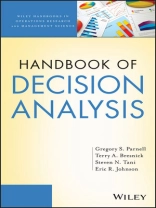A ONE-OF-A-KIND GUIDE TO THE BEST PRACTICES IN DECISION ANALYSIS
Decision analysis provides powerful tools for addressing complex decisions that involve uncertainty and multiple objectives, yet most training materials on the subject overlook the soft skills that are essential for success in the field. This unique resource fills this gap in the decision analysis literature and features both soft personal/interpersonal skills and the hard technical skills involving mathematics and modeling.
Readers will learn how to identify and overcome the numerous challenges of decision making, choose the appropriate decision process, lead and manage teams, and create value for their organization. Performing modeling analysis, assessing risk, and implementing decisions are also addressed throughout. Additional features include:
* Key insights gleaned from decision analysis applications and behavioral decision analysis research
* Integrated coverage of the techniques of single- and multiple-objective decision analysis
* Multiple qualitative and quantitative techniques presented for each key decision analysis task
* Three substantive real-world case studies illustrating diverse strategies for dealing with the challenges of decision making
* Extensive references for mathematical proofs and advanced topics
The Handbook of Decision Analysis is an essential reference for academics and practitioners in various fields including business, operations research, engineering, and science. The book also serves as a supplement for courses at the upper-undergraduate and graduate levels.
Table of Content
List of Figures ix
List of Tables xiii
Foreword xv
Preface xxi
Acknowledgments xxv
About the Authors xxvii
Acronyms xxxi
1 Introduction to Decision Analysis 1
Gregory S. Parnell and Terry A. Bresnick
2 Decision-Making Challenges 22
Terry A. Bresnick and Gregory S. Parnell
3 Foundations of Decision Analysis 46
Gregory S. Parnell and Steven N. Tani
4 Decision Analysis Soft Skills 68
Terry A. Bresnick and Gregory S. Parnell
5 Use the Appropriate Decision Process 92
Steven N. Tani and Gregory S. Parnell
6 Frame the Decision Opportunity 110
Steven N. Tani and Gregory S. Parnell
7 Craft the Decision Objectives and Value Measures 127
Gregory S. Parnell, Terry A. Bresnick, and Eric R. Johnson
8 Design Creative Alternatives 149
Steven N. Tani and Gregory S. Parnell
9 Perform Deterministic Analysis and Develop Insights 166
Eric R. Johnson, Gregory S. Parnell, and Steven N. Tani
10 Quantify Uncertainty 227
Eric R. Johnson and Steven N. Tani
11 Perform Probabilistic Analysis and Identify Insights 248
Eric R. Johnson and Steven N. Tani
12 Portfolio Resource Allocation 291
Terry A. Bresnick, Eric R. Johnson, and Gregory S. Parnell
13 Communicating with Decision Makers and Stakeholders 320
Gregory S. Parnell and Terry A. Bresnick
14 Enable Decision Implementation 340
Terry A. Bresnick and Gregory S. Parnell
15 Summary of Major Themes 351
Gregory S. Parnell
Appendix A: Probability Theory 362
Steven N. Tani
Appendix B: Influence Diagrams 374
Steven N. Tani and Gregory S. Parnell
Appendix C: Decision Conferencing 381
Terry A. Bresnick
Index 392
About the author
GREGORY S. PARNELL, Ph D, is Professor of Systems
Engine-ering at the United States Military Academy at West Point
and Executive Principal Analyst with Innovative Decisions, Inc.
TERRY A. BRESNICK, MBA, is Cofounder of Innovative
Decisions, Inc. and President of Innovative Decision Analysis,
Inc.
STEVEN N. TANI, Ph D, is Partner and Fellow of Strategic
Decisions Group.
ERIC R. JOHNSON, Ph D, is Associate Director at
Bristol-Myers Squibb.












